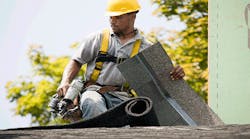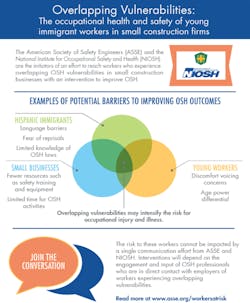Young Hispanic Construction Workers Are the Most Vulnerable in the United States
A joint report conducted by the American Society of Safety Engineers (ASSE) and the National Institute for Occupational Safety and Health (NIOSH) concludes workers who are young and Hispanic and work for small construction firms likely face greater occupational safety and health challenges than almost any other employee segment or industry in the United States.
The report, “Overlapping Vulnerabilities: The Occupational Safety and Health of Young Immigrant Workers in Small Construction Firms,” looks at a variety of existing data sources in order to document overlapping vulnerabilities for workers. It focuses on the factors behind why the population of workers who fall into three categories – Hispanic immigrants, working for small businesses with fewer than 20 employees and young workers under age 25 – are at increased risk for injury and death when working in the construction industry.
“The safety community and the construction industry must take note of this report and work together to improve the safety conditions outlined in it,” said ASSE President Trish Ennis. “ASSE & NIOSH commit to partner with interested parties across the country to develop effective solutions that will allow Hispanic immigrants and small business owners to thrive in a safe work environment.”
Hispanics were the only ethnic group to see an increase in the number of workplace fatalities in 2013. Prior studies have shown that because of their work in dangerous occupations, Hispanic immigrant workers experienced a higher occupational mortality rate (5.9 per 100,000 full-time employees) than all other workers (4.0 per 100,000 full-time employees), according to statistics collected from 1992-2006.
“Improving the health and safety of vulnerable populations recognizes that occupational hazards are distributed differentially,” said NIOSH Director John Howard, M.D. “This collaborative effort provides a foundation that addresses the specific needs of small businesses, minority populations and the many young workers who dedicate themselves to their work.”
In 2013, there were 817 fatal on-the-job injuries on construction sites – more than any other industry. While construction is inherently a high-risk industry, it is even more so for the Hispanic immigrants who account for 82 percent of the 2 million foreign-born immigrants working construction in the U.S.
According to the report, many immigrants are unfamiliar with the risks they face on the job, unaware of standard safety procedures, receive little or no job training, do not speak or comprehend English and may have work styles different from their coworkers and employers.
Historically, small businesses with 20 or fewer employees hire workers who are at a greater risk for occupational injury, including young workers, people who are less educated and immigrants. Typically, these small businesses, which account for 90 percent of all construction firms, do not have an occupational safety and health infrastructure to help them manage standards and injuries.
ASSE and NIOSH plan to work with community groups, national safety organizations, U.S. safety agencies and Latin American consulates where these Hispanic immigrants originate to provide the tools this employee group and its employers need to better manage hazards in the construction industry.
“The report is a starting point,” Ennis said. “ASSE and NIOSH look forward to making recommendations that will improve safety and save lives in the construction industry.”


